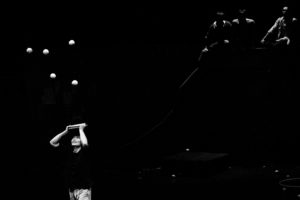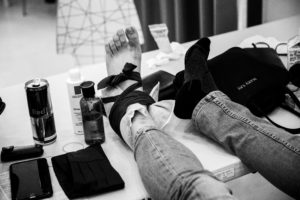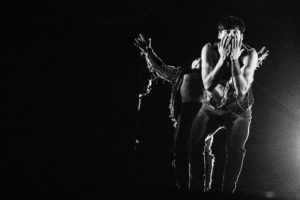Catch Me if You Can: Circus Photography with Taiwan’s Formosa Circus Art

For years, Taiwanese photographer Ken Wang and performer/freelancer Chao Wei Chen have worked with Formosa Circus Art and striven to convey the power of a moving art form in still images. In the last edition of the DuMaXi quarterly, the two men weighed in on their goals, techniques, and philosophies to take the perfect circus photo.
Being in the moment plays an important role in the performing arts field. The live atmosphere is difficult to replace with videos and images. Photography can capture the inspirational side of circus and, sometimes, it even becomes a new mode of creation. Through the construction of the image and the capturing of the moment, a photograph shows the magic of circus in a way that is different from the scene itself.
In this interview, we invited documentary photographer Ken Wang (hereinafter referred to as Ken) and circus artist Chao Wei Chen (hereinafter referred to as Chao) to speak about the artistry of capturing circus on camera. Ken has been shooting and documenting Formosa Circus Art (hereinafter referred to as FOCA) for a long time; he is familiar with the character and movement of these circus artists, and always captures the subtle, magical moments at the right time. Chao has been a member of FOCA for many years. He is a Cyr wheel artist and a keen photographer himself, often bringing his camera to FOCA rehearsals to capture the scenery.
Q: What does photography mean to you?

Chao: Since joining FOCA, I have had many opportunities to travel around and visit different countries. Those memories of our journey were so wonderful that I thought it was a pity not to record them, so I started to take pictures. In the beginning, I just captured the things I saw on the way to the theater, or during show rehearsals. In recent years, I’ve started to record my circus practices by taking a series of photos observing my physical condition. Photography is a third eye that helps my body adjust to a more perfect form.
Ken: I started to take photographs during my time as a student. At that time, I read a lot of photo collections from different photographers. By taking inspiration and experiences from many sources, I gradually learned what style and type of image I was eager to chase. After graduation, I worked in a commercial photography studio and accumulated technical training, but I was still interested in capturing people’s emotions and bodies on camera. Later on, I met some friends from theater and dance fields when studying for my Master’s in England. That was my official starting point in theater photography. As soon as I finished my degree program and returned to Taiwan, I started looking for theater or related collaborative opportunities, and FOCA was the one. That was how my journey started in 2016.
Q: This question goes to Ken. What are your key points about capturing circuses for years?
Ken: The movement of a circus performance is very fast, and the mistake rate is higher than in other performing arts fields. Many photographers will use burst mode, but I try not to. I would like to present a more perceptive and story-oriented side of circus— not to say a more artistic one, but I hope to bring more inspiration to the viewer. Basically, on each project I have worked, I’ve shot behind the scenes as well. It’s a kind of warm-up for me: I walk around, observe the status of the performers, and see what the crew is up to. The space, the warm-up, and even the prayer ceremony before the show—they’re the best ways to get me into shape.

Chao: The warm-up state Ken is talking about is actually the same as when I am preparing before the show. Whenever I’m warming up next to him and notice his eyes sparkling in the background, I know he’s coming into his own. It’s his performance, too; he uses photography to express himself.
Q: Talk about the predicament of “Making Mistakes” in circus performance and photography. When you make a mistake, how do you deal with it?
Ken: The theater itself is a place of creation: everyone is creating or exploring, and my creation is taking pictures. There is no right way to shoot a theatre photograph. As long as the photo can make the viewer feel something—make them feel good—tell them a story, and make their eyes want to stay, it is a good photo. There is no such thing as “Making Mistakes” in photography— just different ways of looking at it.
Chao: I remember one time when you had taken a photo that was out of focus. I don’t know if it was an accident, but at the moment of looking at it, I felt that you did it on purpose. Later on, I thought that maybe the camera had really been off right when you pressed it. But that photo did express the unstable state of the circus performer well.

As a Cyr wheel artist, I’ve always determined “How should I react if I make mistake while performing?” before every performance, and what I’d have to do afterward to keep the scene from lingering. Even if I make a mistake, as long as I don’t stay in the mind frame of “damn it, I made a mistake” and think about how to deal with it beforehand, then the mistake can become something cute, or its meaning can be transformed by the audience, just like the feeling that the out-of-focus photo gave me.
Ken: That’s one interesting thing about circus. In other performing art fields, such as drama or dance, it is not easy to sense when there is something wrong on the stage, but in circus, it’s a totally different situation.
Q: Share the next stage of how you want to challenge yourselves as circus photographers.

Ken: Over the past few years, I’ve become more aware of what I want to capture on camera. I wait and try to press the shutter button as little as possible, and instead spend more time observing, looking for angles, and watching the show unfold continuously. Before I would watch the artists’ movements in rehearsals to get a better idea of what would go on in the formal performance and what angles would be available to me. Sometimes, after shooting for a long while, I feel that this is enough. But when I look back on it, I’ll wonder, why didn’t I follow the artists at that moment? Why didn’t I press the shutter? In FOCA’s case, it’s worth recording even the moment when someone was injured, say, but I was too embarrassed to keep pressing the shutter at that time.
Chao: Right. One time at a rehearsal at the Weiwuying Circus Platform, I kicked my foot and cracked the bone. I was lying on the ground, wailing in pain, and then I heard the shutter clicking beside me!
People may think that circus performers want to show off their most difficult skills and be captured at the most exciting moment. But I prefer to know what the relationship is between me and my props when I am performing. Are there any emotions I am not aware of yet that I unconsciously reveal through my performance? As both a circus artist and a photographer, I understand the core of what each shot should focus on, but I haven’t found the connection between the two that adds up yet. How do I create the best angles and emotions for the photographer to capture? And what kinds of brilliant images can I capture myself? I am still searching for answers to both questions, and finding them is my next goal.

All images in this article were taken by Ken Wang of KEN Photography. Special thanks to Lo Xin-Tong and Martina Lin for the interview text and translation.
Editor's Note: At StageLync, an international platform for the performing arts, we celebrate the diversity of our writers' backgrounds. We recognize and support their choice to use either American or British English in their articles, respecting their individual preferences and origins. This policy allows us to embrace a wide range of linguistic expressions, enriching our content and reflecting the global nature of our community.
🎧 Join us on the StageLync Podcast for inspiring stories from the world of performing arts! Tune in to hear from the creative minds who bring magic to life, both onstage and behind the scenes. 🎙️ 👉 Listen now!
